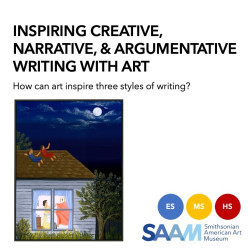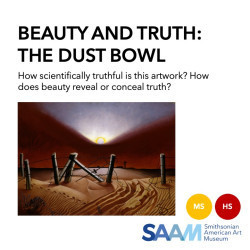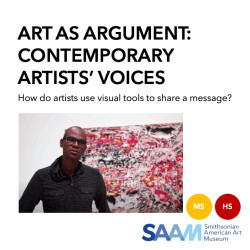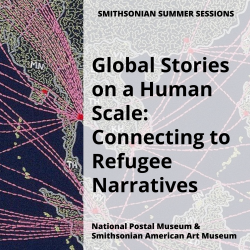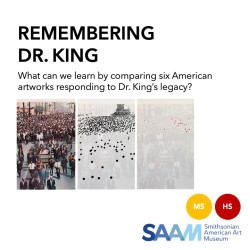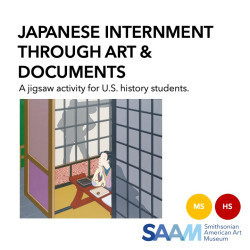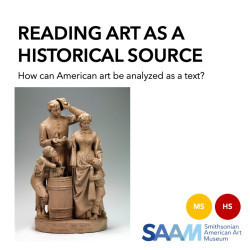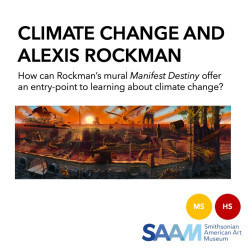Phoebe Hillemann
Teacher Institutes Educator
Smithsonian American Art Museum
As the Teacher Institutes Educator at the Smithsonian American Art Museum, I organize our week-long summer institutes for middle and high school English and social studies teachers: http://americanart.si.edu/institutes. I'm interested in interdisciplinary thinking, arts integration, and the power of dialogue in learning spaces.
Phoebe Hillemann's collections
Teaching Immigration & Migration through American Art
<p>Essential Question: How have immigration and migration –both voluntary and involuntary – shaped American culture?</p>
<p>This collection was created to support a session presented in the 2024 National Council for the Social Studies (NCSS) annual conference in Boston, MA. All artworks are from the Smithsonian American Art Museum's collection. </p>
<p>Explore more teaching resources from SAAM: <a href="https://americanart.si.edu/education/k-12/resources">https://americanart.si.edu/edu...</a></p>
 Phoebe Hillemann
Phoebe Hillemann
54
Inspiring Creative, Narrative, & Argumentative Writing with Art
<p>Explore different styles of writing in response to American art! This digital collection suggests artworks from the Smithsonian American Art Museum to use to inspire creative, narrative, and argumentative writing, along with suggested thinking routines and writing prompts. The categories are fluid -- many artworks can be used successfully for more than one type of writing!<br></p>
 Phoebe Hillemann
Phoebe Hillemann
37
Beauty and Truth: The Dust Bowl
<p>This collection explores Alexandre Hogue's 1933 painting <em>Dust Bowl</em> through a global thinking routine called "Beauty and Truth." Supporting materials help build historical and scientific context. </p>
<p><em>“Some may feel that in these paintings . . . I may have chosen an unpleasant subject, but after all the [drought] is most unpleasant. To record its beautiful moments without its tragedy would be false indeed. At one and the same time the [drought] is beautiful in its effects and terrifying in its results. The former shows peace on the surface but the latter reveals tragedy underneath. Tragedy as I have used it is simply visual psychology, which is beautiful in a terrifying way.” -Alexandre Hogue</em></p>
<p><br /></p>
 Phoebe Hillemann
Phoebe Hillemann
12
Remembering Dr. King: Six American Artists Respond
<p>April 4, 2018 marks the 50th anniversary of the assassination of Martin Luther King, Jr. These six artworks from the Smithsonian American Art Museum's collection were created between 1968 and 1996, and respond to Dr. King's legacy in different ways. What does the date of each artwork tell us about the context during which it was made? What can we learn from looking at them as a collection?</p>
<p>Created for a March 1, 2018 webinar for alumni of SAAM's Summer Institutes: Teaching the Humanities through Art. </p>
<p><a href="https://americanart.si.edu/education/k-12/professional-development/summer-institutes" style="background-color:rgb(63,63,63);">https://americanart.si.edu/edu...</a> </p>
<p>#saamteach #martinlutherkingjr #mlk</p>
 Phoebe Hillemann
Phoebe Hillemann
8
Japanese American Incarceration through Art and Documents
<p>These resources can be used in an activity that introduces a lesson on Japanese American Incarceration during World War II. </p>
<p>1. To begin, show students Roger Shimomura's painting entitled Diary: December 12, 1941. Without providing any background information, use the "Claim, Support, Question" routine to have students make claims about what they think is going on in the artwork, identify visual support for their claims, and share the questions they have about the painting. Document responses in three columns on large chart paper or a whiteboard.</p>
<p>2. Following this initial conversation, share the title, artist's name, and date of the painting. Ask students to consider the date in the title, and discuss what significance this date might have. If they don't figure out that this date was five days after the Japanese bombing of Pearl Harbor, share that information. Share with students that this painting is part of a series Roger Shimomura created based on the wartime diary entries of his grandmother, Toku, who was born in Japan and immigrated to Seattle, Washington in 1912. Along with thousands of other people of Japanese ancestry living on the West Coast during World War II , Toku and her family were forcibly relocated to an incarceration camp after the attack on Pearl Harbor. Roger was a young boy during World War II, and remembers spending his third birthday in the Puyallup Assembly Center on the Washington state fairgrounds, where his family was sent before being transferred to Minidoka Reservation in Idaho for the duration of the war.</p>
<p>3. Jigsaw Activity, Pt. 1. After sharing this context, tell students they will each be receiving a primary source document that relates to the painting in some way. Distribute copies of "Woman at Writing Table," the Superman comic, the Instructions to All Persons of Japanese Ancestry, and Toku Shimomura's diary entries. Divide students into four groups, one per document. Give students time to analyze their document as a group and discuss how it affects their interpretation of the painting.</p>
<p>4. Jigsaw Activity, Pt. 2. Next, create new groups so that each group includes students who received each of the four sources. Ask students to briefly report on their document and what their original group discussed as its possible meaning and relation to Roger Shimomura's painting.</p>
<p>5. Return to the painting as a large group, and discuss how the primary source documents have influenced students' reading of the artwork. </p>
<p>6. Optional additional resource: If time allows, have students watch excerpts from Roger Shimomura's artist talk at the Smithsonian American Art Museum.</p>
<p>#APA2018</p>
<p><em>#visiblethinking</em><br></p>
 Phoebe Hillemann
Phoebe Hillemann
9
Reading American Art as a Historical Source
<p>How can American art be read as a historical text? How can it be used to explore the 2018 National History Day theme of "Conflict and Compromise in History"? This collection examines two works of American art closely, modeling the process of historical inquiry and analysis. It also shares several online resources on reading artwork in a historical context, and suggests additional artworks from SAAM's collection that might support the theme of Conflict and Compromise.</p>
<p>#NHD2018 #NHD</p>
<p>Keywords: Reconstruction, Civil War, John Rogers, Winslow Homer<br></p>
<p><em>#historicalthinking</em></p>
<p><br></p>
 Phoebe Hillemann
Phoebe Hillemann
30
No Spectators: The Art of Burning Man
<p>Each year in Nevada’s Black Rock Desert, a city of more than 70,000 people rises out of the dust for a single week. During that time, enormous experimental art installations are erected and many are ritually burned to the ground. The thriving temporary metropolis known as Burning Man is a hotbed of artistic ingenuity, driving innovation through its principles of radical self-expression, decommodification, communal participation, and reverence for the handmade. Both a cultural movement and an annual event, Burning Man remains one of the most influential phenomenons in contemporary American art and culture.<br /></p>
<p><em>No Spectators: The Art of Burning Man, </em>an exhibition at the Smithsonian's Renwick Gallery, brings the large-scale, participatory work from this desert gathering to the nation’s capital for the first time. This collection features video interviews with many of the artists whose artwork is featured in the show.</p><p><br /></p><p>Keywords: STEM, STEAM, Design Thinking, Installation Art, Public Art</p>
 Phoebe Hillemann
Phoebe Hillemann
17
Be The Curator with SAAM and NPG Collections
<p>Resources from the P21 Exemplar Teacher Workshop held at SAAM and NPG February 28, 2017.</p>
 Phoebe Hillemann
Phoebe Hillemann
10
The Subway
Artworks, photographs, and other documents relating to the New York subway system.
 Phoebe Hillemann
Phoebe Hillemann
8
Life in DC: Then and Now
<p>Explore images of Washington, DC, using artworks in the Smithsonian American Art Museum. Compare them to the present, learning about changing neighborhoods, people and daily life, natural resources, and arts & culture. This collection can be adapted for students of different grade levels learning about DC history.</p>
 Phoebe Hillemann
Phoebe Hillemann
38
Art as Argument: Dust Bowl to Climate Change
<p>How have American artists used visuals to bring attention to the pressing issues of their time? Compare and contrast a 1930s painting about the Dust Bowl with one addressing climate change made seventy years later, interpreting them in context to discover continuity and change over time. </p>
<p>Possible thinking questions for students to use with one or both paintings:</p>
<p></p>
<ul><li>Are these artworks primary sources? Does your answer depend on the context in which they are used?</li><li>What is "truthful" about these artworks? How might we use other sources to corroborate or check their truthfulness?</li><li>What do you think are the most effective media for making a compelling argument? Why? Student might consider speeches, photographs, newspaper op-eds, data visualizations like charts and graphs, videos/films, music, and visual art.</li></ul><p>Resources compiled for a March 2020 National Council for History Education (NCHE) conference session.<br /></p><p></p>
 Phoebe Hillemann
Phoebe Hillemann
11
#BecauseOfHerStory: Exploring Untold Stories through Portraiture and American Art
<p>Learn how American art and portraiture can bring diverse women’s stories into your classroom, connecting with themes you may already teach. Discover strategies for engaging your students in close looking and critical thinking across disciplines. #SAAMTeach #NPGteach<br /></p>
<p>RELATED WEBINAR SERIES (recordings available): <a href="https://americanart.si.edu/education/k-12/professional-development/webinars">https://americanart.si.edu/education/k-12/professional-development/webinars</a></p>
<p>This project received support from the Smithsonian American Women’s History Initiative. To learn more, visit the <a href="https://womenshistory.si.edu/">Smithsonian American Women History Initiative website</a>. #BecauseOfHerStory</p>
<p><br /></p>
 Phoebe Hillemann
Phoebe Hillemann
19

